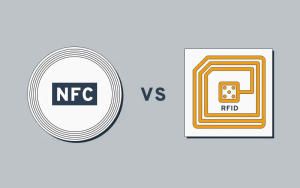6 Min Read
In the fast-paced realm of industrial operations, efficiency and precision are paramount. One technological marvel that has revolutionized the landscape of asset management is the Near Field Communication (NFC) technology.
 This article delves into the world of Industrial Asset Tracking NFC, unraveling the layers of its functionality, different types of NFC devices, and the key benefits of an efficient NFC asset tracking system.
This article delves into the world of Industrial Asset Tracking NFC, unraveling the layers of its functionality, different types of NFC devices, and the key benefits of an efficient NFC asset tracking system.
What is Near Field Communication Asset Tracking?
Near Field Communication (NFC) Asset Tracking is a sophisticated system that leverages the power of short-range wireless communication to monitor and manage industrial assets with unparalleled efficiency. At its core, NFC enables devices to establish a seamless connection when in close proximity.
Applied to asset tracking systems, this technology enables swift and contactless data exchange between NFC-enabled tags or labels affixed to assets and corresponding readers or devices.

NFC Asset Tracking involves affixing NFC tags or labels to individual assets, creating a digital thread that links the physical object to a comprehensive database. This database contains vital information about the asset, including its location, maintenance history, and other relevant details.
As assets move through a facility or warehouse, NFC-enabled devices can read and update the information on these tags in real time, providing a dynamic and accurate overview of asset movements and status. This level of precision not only minimizes the risk of loss or theft but also facilitates efficient inventory management, preventive maintenance scheduling, and overall operational optimization.
Smarter Asset Tracking With NFC Tags
Learn more about how NonStop Suite's NFC Asset Tracking Solution can help your Enterprise streamline operations to new heights.
Get A Free Product Tour
How Does NFC Work?
NFC tags operate on the principles of electromagnetic induction and radio frequency identification (RFID). NFC-enabled devices, such as smartphones or dedicated readers, have a built-in NFC chip that allows them to communicate with other NFC-enabled objects.
Data communications begin with one device generating a radiofrequency field. When an NFC tag or label is brought into this field, it induces a current in the tag’s antenna, powering the tag and enabling the transfer of data.
NFC and RFID tags process two-way communication: active and passive modes. In the passive mode, the NFC tag draws power from the initiating device’s field and responds by transmitting its stored information. This is commonly employed in asset tracking scenarios where the tag holds crucial data about the associated asset.
On the other hand, in active mode, both devices generate their respective fields, allowing them to exchange information seamlessly. This mode is often seen in peer-to-peer interactions, such as mobile payments or data sharing between two smartphones.
Types Of NFC Devices
A variety of devices play key roles in ensuring the smooth flow of information. Here are the primary types of NFC devices commonly employed in industrial settings:
- Smartphones and Tablets: The most ubiquitous NFC device is a mobile device equipped with NFC chips. These mobile devices serve as multifunctional tools, enabling users to make contactless payments, share files, and engage in various NFC applications.
- NFC Tags and Labels: These asset tags are small, passive devices with data storage facilities that can be affixed to assets, products, or even physical locations. NFC tags and labels are the workhorses of asset tracking, allowing for easy and efficient data exchange when in proximity to an NFC-enabled device.

- NFC Reader and Writer: Dedicated NFC readers and writers are essential components in asset tracking systems that are designed to interact with NFC tags, retrieving or updating information as needed. Asset managers can integrate these devices into fixed points within a facility, such as entry gates or specific workstations.
- Wearables: Wearable devices, like smartwatches or fitness trackers, are increasingly becoming an attractive option in NFC technology. Beyond facilitating quick and secure payments, NFC wearables can also be utilized for controlling existing systems, real-time tracking, and even monitoring equipment usage.

- POS Terminals: Point-of-sale (POS) terminals with NFC capabilities have become standard in modern environments such as payment terminals. These terminals enable contactless payments, making transactions faster and more convenient.In an industrial context, similar terminals can be employed for tracking and managing asset-related transactions.

- Access Control Systems: NFC is a common feature in access control systems, providing a secure and efficient means of entry. From keycards to electronic door locks, these systems leverage NFC to grant or restrict access based on authentication.
Why Use NFC Tags For Tracking Assets?
Utilizing Near Field Communication (NFC) tags offers several benefits to businesses. Here are some of the many advantages of NFC tags:
Accurate
Compared to other methods, NFC tags provide a high degree of accuracy in asset tracking. The short-range communication ensures that the device must be in close proximity to the tag for data exchange, which minimizes the risk of errors and inaccuracies.
This precision is crucial in industries where the exact location and status of assets play a pivotal role in operational efficiency.
Convenient
With the ubiquity of NFC-enabled devices, such as smartphones and tablets, tracking assets becomes a hassle-free task. Using NFC tags, personnel can easily scan physical assets with their devices, eliminating the need for complex equipment or time-consuming manual processes.
Automated
As some assets move within the facility, NFC tags automatically communicate with readers or devices and update asset status in real time. This automation reduces reliance on manual data entry, minimizing human error and ensuring that the asset information is always up-to-date.
Cost Reduction
Implementing NFC technology for asset tracking can lead to significant cost reductions. The automation and accuracy it brings result in more efficient use of resources reduced labor costs associated with manual tracking, and prevention of losses due to misplaced or unidentified assets.
Better Speed
NFC facilitates swift and seamless data exchange, contributing to faster asset-tracking processes. The quick communication between the NFC tag and the reading device ensures that asset information is retrieved or updated in real-time, enhancing overall operational speed and responsiveness.
Secure
Asset security is paramount in industrial settings, and NFC technology provides a secure means of asset tracking by providing total visibility of asset status. The short communication range ensures that the data exchange is localized, reducing the risk of unauthorized access or interception.
Additionally, NFC can support encryption protocols, adding an extra layer of security to the transmitted information.
Flexible
NFC tags offer flexibility in terms of their form factors and applications. They can be integrated into various types of assets, including equipment, tools, and inventory. The flexibility extends to the types of information stored on the tags, allowing for customization based on specific tracking requirements.
Scalable
NFC asset-tracking solutions are scalable to accommodate the evolving needs of an industrial environment. Whether the facility expands, the number of tracked assets increases, or new functionalities are required, NFC systems can be easily scaled up without a significant infrastructure overhaul.
What's The Better Option? NFC Technology Vs. RFID Technology
In the perennial debate between Near Field Communication (NFC) and Radio-Frequency Identification (RFID) technologies, each has its unique strengths and applications, making the choice between the two a nuanced decision.

Benefits of NFC vs RFID
Choosing between NFC and RFID technologies involves understanding their distinct advantages. NFC, operating within a limited range of a few centimeters, boasts enhanced security due to its proximity requirement, making it less susceptible to unauthorized access.
Additionally, NFC is more versatile, as it enables two-way communication between devices.
In contrast, RFID operates over a longer range, which can be advantageous for tracking assets in a broader space but may pose security concerns. NFC’s compatibility with smartphones and its ability to facilitate secure mobile transactions further contribute to its appeal in modern applications.
While RFID excels in scenarios requiring a broader coverage area, NFC stands out for its security features and adaptability to diverse applications.
Application of NFC vs RFID
The choice between NFC and RFID also hinges on the specific requirements of the application. NFC finds its forte in applications where close-range communication is paramount, such as contactless payments, ticketing, and access control. Its prevalence in smartphones and wearables makes it ideal for consumer-oriented applications, providing a seamless and secure user experience.
On the other hand, RFID, with its longer communication range, is well-suited for scenarios demanding the tracking of assets across larger areas, like supply chain management, logistics, and inventory tracking. RFID’s ability to handle simultaneous communication with multiple tags makes it efficient in scenarios requiring bulk data capture.
Ultimately, the application context determines the more suitable technology, with NFC excelling in close-range interactions and RFID dominating in situations demanding broader coverage.
Enjoy Seamless Asset Management And Tracking With NFC Tags
The power of Near Field Communication (NFC) tags for managing assets heralds a new era of efficiency and precision. The seamless interaction between NFC tags and devices facilitates not only the accurate tracking of assets but also a comprehensive approach to data transmission.
Managing assets becomes a streamlined and automated process, reducing the margin for error and enhancing overall operational efficacy. The advantages of NFC technology make it a compelling choice for modern asset management solutions.
Unlock the full potential of your operations with the simplicity and power of NFC technology with The NonStop Group. As industries forge ahead into a future driven by innovation, the integration of NonStop Suite’s NFC technology emerges as a transformative step towards optimizing processes, reducing costs, and ensuring a secure and scalable approach to asset tracking.
Learn more.
